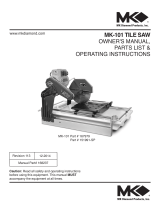Page is loading ...

No. 837 Dust Cover
Installation Instructions
STEP ONE:
SWITCH OFF AND
UNPLUG SAW! BLADE
MUST NOT BE TURNING.
IMPORTANT: Follow all
instructions of the saw
instruction manual.
Wear safety glasses
when installing, using, or
cleaning the Saw or Dust
Cover.
Remove depth gauge
that comes with the saw.
A Phillips screwdriver is
needed to remove the
Phillips head screw.
STEP THREE:
Insert the Three Arm
Knob provided with the
Dust Cover at the mount-
ing hole and tighten
down.
THREE ARM KNOB
WARNING:
KEEP HANDS
AWAY FROM THE
SAW BLADE!
USE THREE ARM
KNOB PROVIDED
WITH DUST COVER.
DOG POINT SET
SCREW IS EASIER
TO INSERT.
STEP TWO:
A. Retract the Movable
Guard by hand.
B. Place the Dust Cov-
er on the saw so that
the mounting holes are
aligned.
Remove Phillips head
screw with screwdriver.
Remove Three Arm
Knob.
Depth
Gauge
Retract Movable
Guard by hand.
A
Position Dust Cover by
aligning the mounting
holes.
Mounting holes aligned.
DOG POINT
SET SCREW
B

STEP FOUR:
Adjust the Pivoting Depth Gauge.
Loosen the Pivoting Depth Gauge 3
Arm Knob.
Extend the Pivoting Depth Gauge to
create the desired depth of cut.
Pivoting Depth Gauge is adjustable
from ³⁄
8
" minimum to 1³⁄
32
" maximum.
STEP FIVE:
For best dust control performance
Connect a dust vacuum at the Dust
Control Port.
Pivoting
Depth
Gauge
Pivoting
Depth
Gauge
Dust
Shroud
Pivoting
Depth
Gauge
3 Arm
Knob
Dust
Control
Port
USAGE INSTRUCTIONS:
When undercutting wood base or other trim, use the Pivoting Depth Gauge to set
the depth of cut to the thickness of the wood base or other trim only. In general,
undercut to the minimum necessary depth required to fit the new flooring under-
neath. Avoid cutting too deep into the sheetrock or wall studs.
The Dust Shroud is spring-loaded and follows the contour of the floor to capture as
much dust as possible. If the Dust Shroud becomes jammed, so that it no longer
extends, clean out using a brush or compressed air. Check that the Dust Shroud
functions properly before each use.
To undercut inside corner areas, this Dust Cover must be removed. Replace Dust
Cover after undercutting the inside corner.
WARNING: Dust Cover (or the Depth Gauge that comes with the saw) covers the
blade and makes the saw safer to use. Always replace the Dust Cover or Depth
Gauge after inside corner cutting is complete.
WARNING:
Some dust created by power sanding, sawing, grinding, drilling, and other construction activities contains chemicals known
to the State of California to cause cancer, birth defects or other reproductive harm. Some examples of these chemicals are:
• lead from lead-based paints,
• crystalline silica from brick, cement and other masonry product, and
•
arsenic and chromium from chemically-treated lumber.
Your risk from these exposures varies, depending on how often you do this type of work. To reduce your exposure to these chemicals:
work in a well-ventilated area, and work with approved safety equipment, such as those dust masks that are specially designed to lter
out microscopic particles.
WARNING: grinding, cutting, or drilling of stone, masonry, brick, concrete, metal, ceramic tile and other materials with silica in their
composition may give off dust or mists containing crystalline silica. Silica is a basic component of sand, quartz, brick clay, granite,
marble and numerous other minerals and rocks. Inhalation of airborne crystalline silica can cause serious or fatal respiratory diseases,
including silicosis. Use OSHA and NIOSH approved dust monitoring, dust control, dust collection and respiratory protection equipment
and methods, and follow all applicable regulations.
/






